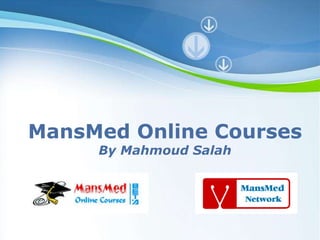
Introduction to Moodle
- 1. Powerpoint Templates MansMed Online Courses By Mahmoud Salah
- 2. What Is a Course Management System? CMSs are web applications, meaning that they run on a server and are accessed by using a web browser. Your Moodle server is probably located in your university or department, but it can be anywhere in the world. You and your students can access the system from any place with an Internet connection.
- 3. Let’s take a quick look at each of these features and how they might be useful: Uploading and sharing materials Most CMSs provide tools to easily publish content. Instead of using an HTML editor and then sending your documents to a server via FTP, you simply use a web form to store your syllabus on the server.
- 4. Forums and chats Online forums and chats provide a means of communication outside of classroom meetings. Forums give your students more time to generate their responses and can lead to more thoughtful discussions. Chats, on the other hand, give you a way to quickly and easily communicate with remote students. They can be used for project discussions between groups of students or for last-minute questions the day before an exam.
- 5. Quizzes Online quizzes can be graded instantaneously. They are a great tool for giving students rapid feedback on their performance and for gauging their comprehension of materials.
- 6. Gathering and reviewing assignments Online assignment submissions are an easy way to track and grade student assignments. In addition to grading student assignments yourself, research indicates that using an online environment for student peer reviews increases student motivation and performance.
- 7. Recording grades An online gradebook can give your students up-to-date information about their performances in your course. Online grades can also help you comply with new privacy rules that prohibit postin grades with personal identifiers in public places.CMS gradebooks allow students to see only their own grades, never another student’s. You can also download the grades into Excel for advanced calculations.
- 8. Why Should You Use a CMS? Good question. After all, we’ve run classes for thousands of years without the use of computers and the Web. “Chalk and talk” is still the predominant method of delivering instruction. While traditional face-to-face meetings can still be effective, applying the tools listed above opens up new possibilities for learning that weren’t possible twenty years ago. Currently, there is a lot of research into how to effectively combine online learning and face-to-face meetings in what are called “hybrid” courses or “blended learning.”
- 9. Online discussions give many students the opportunity to express themselves in ways they couldn’t in a regular class. Many students are reluctant to speak in class because of shyness, uncertainty, or language issues. It’s a boon to many students to have the ability to take their time to compose questions and answers in an online discussion, and instructors report much higher participation levels online than in class.
- 10. Student demand Students are becoming more technically savvy, and they want to get many of their course materials off the Web. Once online, they can access the latest information at any time and make as many copies of the materials as they need. Having grown up with instant messaging and other Internet communication tools, many students find that online communication is second nature.
- 11. Better courses If used well, CMSs can make your classes more effective and efficient. By moving some parts of your course online, you can more effectively take advantage of scheduled face-to-face time to engage students’ questions and ideas. For example, if you move your content delivery from an in-class lecture to an online document, you can then use lecture time to ask students about what they didn’t understand. If you also use an online forum, you can bring the best ideas and questions from the forum into your classroom. We’ll discuss lots of strategies and case studies for effective practice throughout the book.
- 13. Powerpoint Templates Thank you